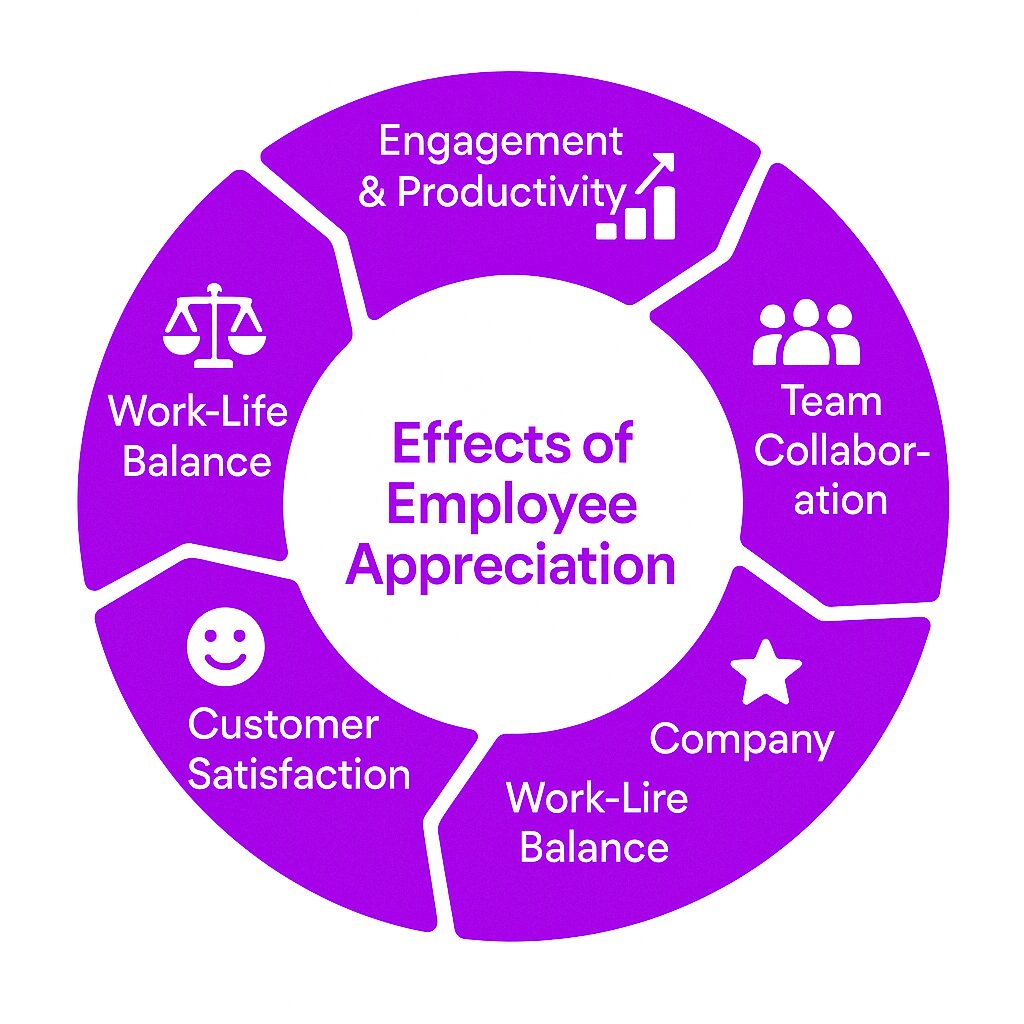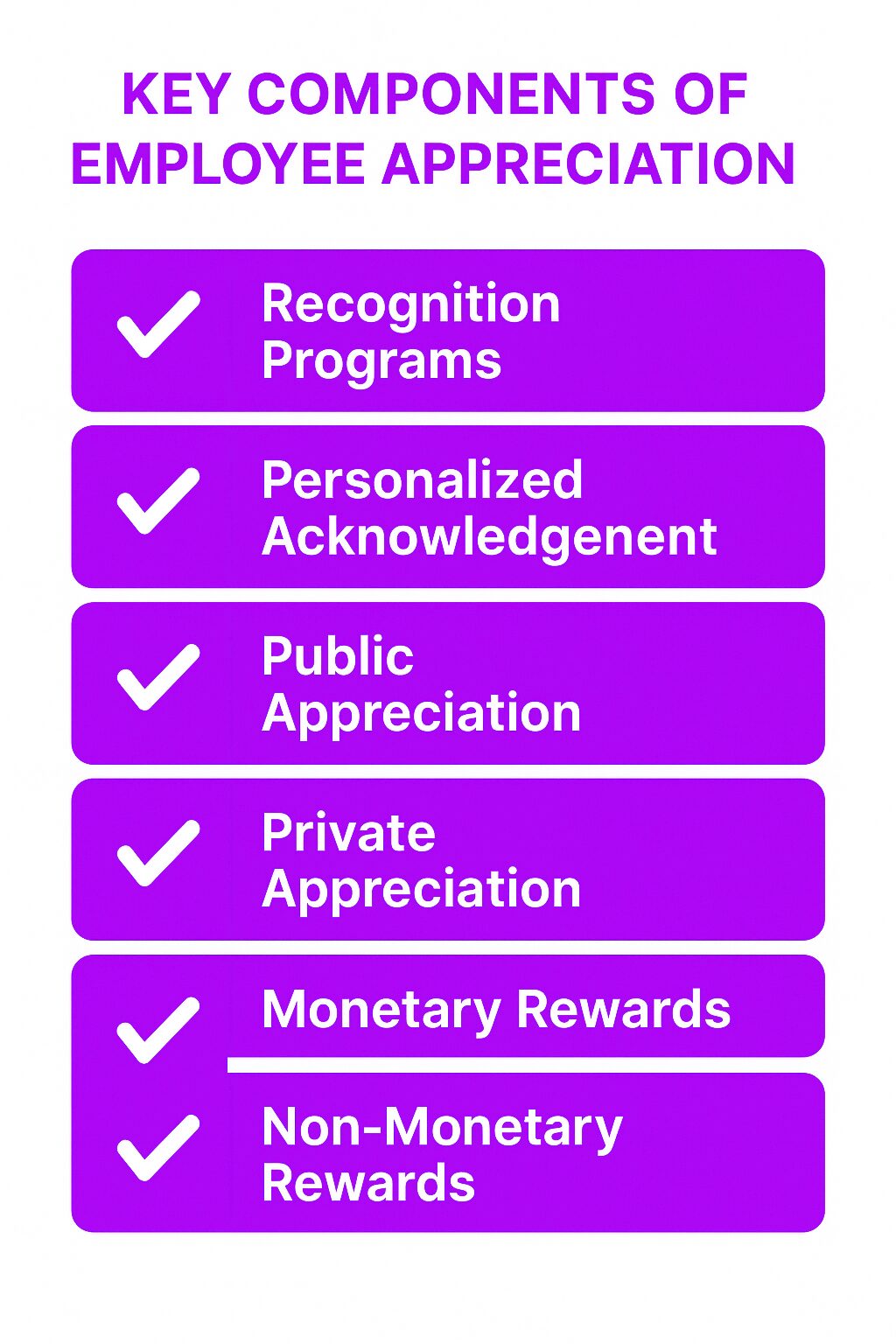What is Employee Appreciation?
Employee appreciation is the act of recognizing and valuing employees for their contributions, achievements, and dedication to the organization. It goes beyond basic compensation and benefits—it creates a workplace culture where employees feel valued and motivated. Appreciation can be expressed in various ways, from verbal acknowledgment to structured recognition programs. Companies that implement an employee appreciation program to ensure consistent and meaningful appreciation initiatives experience higher employee engagement, retention, and productivity.
Why Employee Appreciation Matters
People want to feel that their work matters. Employee happiness is crucial for productivity and retention, and appreciation efforts significantly contribute to it. When employees are recognized, they feel more engaged, committed, and motivated to perform at their best. A lack of appreciation leads to disengagement, low morale, and high turnover. Organizations that prioritize appreciation benefit from a more positive workplace culture, stronger teamwork, and improved business outcomes.
Effects of Employee Appreciation
-
Increased employee engagement and productivity
-
Lower turnover rates and higher retention
-
Stronger team collaboration and morale
-
Positive company reputation, making it easier to attract top talent
-
Enhanced customer satisfaction due to motivated employees
-
Support for work life balance, leading to a healthier and more productive work environment
Key Components of Employee Appreciation
Recognition Programs
Companies implement structured programs for recognizing employees, which are essential for promoting workplace morale and engagement. Examples include “Employee of the Month” awards, annual recognition events, and milestone celebrations.
Personalized Acknowledgment
Recognition is most effective when it is tailored to the individual. Some employees appreciate public praise, while others prefer a private thank-you. Understanding what each employee values is key.
Public vs. Private Recognition
-
Public Appreciation: Acknowledging employees in front of their peers, during meetings, or on company-wide platforms.
-
Private Appreciation: Personal thank-you messages, one-on-one meetings, or written notes expressing gratitude.
Monetary vs. Non-Monetary Rewards
-
Monetary: Bonuses, salary increases, or gift cards.
-
Non-Monetary: Extra time off, flexible work arrangements, handwritten notes, or company-sponsored experiences.
Culture of Continuous Feedback
Appreciation should be woven into daily interactions, not reserved for annual events. A culture of continuous feedback and recognition ensures that employees feel valued throughout the year. This continuous feedback not only makes employees feel valued but also inspires other team members to engage in a collaborative spirit.
Purpose and Benefits of Employee Appreciation
For the Organization
-
Improves retention by reducing turnover
-
Creates a positive work culture that attracts top talent
-
Enhances productivity as employees feel more motivated
-
Strengthens team dynamics and collaboration
-
Increases employee loyalty and advocacy
For the Employee
-
Boosts morale and motivation
-
Provides a sense of accomplishment
-
Encourages personal and professional growth
-
Strengthens connection with company values
-
Enhances overall job satisfaction
Celebrating Employee Appreciation Day
History and Purpose
Employee Appreciation Day, celebrated on the first Friday of March each year, is a special occasion dedicated to recognizing and appreciating the hard work and contributions of employees. This day was established to remind organizations of the importance of showing genuine appreciation to their team members. By celebrating Employee Appreciation Day, companies can significantly boost employee engagement, productivity, and overall job satisfaction. It’s a day to make employees feel valued and acknowledged for their dedication and efforts.
Benefits and Ideas for Celebration
Celebrating Employee Appreciation Day can bring numerous benefits to an organization, including:
-
Boosting Employee Morale and Motivation: Acknowledging employees’ hard work can lift their spirits and encourage them to continue performing at their best.
-
Improving Employee Retention and Reducing Turnover: When employees feel appreciated, they are more likely to stay with the company, reducing turnover rates.
-
Enhancing Company Culture and Reputation: A culture of appreciation fosters a positive workplace environment and enhances the company’s reputation as a great place to work.
-
Increasing Employee Engagement and Productivity: Recognized employees are more engaged and productive, contributing to the overall success of the organization.
Here are some creative ideas for celebrating Employee Appreciation Day:
-
Give Employees a Day Off or a Flexible Schedule: Allowing employees to take a day off or offering flexible working hours can be a great way to show appreciation.
-
Provide a Catered Meal or Snacks: Treating employees to a catered lunch or snacks can make them feel valued and appreciated.
-
Offer a Gift or Reward: Consider giving gift cards, bonuses, or other rewards to show your appreciation.
-
Create a Recognition Program or Award Ceremony: Organize an event to publicly recognize and celebrate employees’ achievements.
-
Host a Team-Building Activity or Outing: Plan a fun team-building activity or outing to strengthen team bonds and show appreciation.
-
Write a Heartfelt Thank-You Note or Message: A sincere thank-you note or message can go a long way in making employees feel appreciated.
Employee Appreciation Messages and Quotes
How to Write a Good Message
Crafting a meaningful employee appreciation message can sometimes be challenging. Here are some tips to help you write a message that resonates:
-
Be Specific and Sincere: Mention specific actions or behaviors that you appreciate, and ensure your message is heartfelt.
-
Use Natural and Authentic Language: Write in a way that feels genuine and true to your voice.
-
Focus on the Behavior or Action: Highlight what the employee did, rather than just praising the person.
-
Keep It Concise and to the Point: A brief, well-crafted message can be more impactful than a lengthy one.
-
Use a Positive and Uplifting Tone: Ensure your message is encouraging and positive.
Challenges of Employee Appreciation
Lack of Consistency
Inconsistent recognition leads to employees feeling undervalued. Appreciation efforts must be intentional and regularly practiced.
Generic Recognition
Employees can tell when recognition is not sincere. A simple “good job” without specific feedback often feels hollow, while specific feedback can make all the difference in how employees perceive recognition.
Overemphasis on Monetary Rewards
While financial incentives are appreciated, appreciation should not rely solely on money. Employees also value meaningful interactions and genuine recognition.
Managerial Resistance
Some managers may not see appreciation as a priority or may struggle with providing meaningful recognition. Training leaders on the importance of appreciation can help integrate it into daily management practices.
Best Practices for Employee Appreciation
Be Timely
Recognition should happen as soon as an employee accomplishes something noteworthy. Delayed appreciation reduces its impact.
Be Specific
Instead of saying “Great work,” explain why their contribution mattered. Specific praise makes employees feel truly valued.
Encourage Peer Recognition
Appreciation shouldn’t only come from managers. Encouraging employees to recognize each other fosters a culture of gratitude and teamwork.
Utilize Different Forms of Recognition
Some employees value verbal praise, while others appreciate written notes, social recognition, or financial rewards. Offering a variety of recognition methods ensures inclusivity.
Incorporate Recognition Into Company Culture
Make appreciation a natural part of the workplace by embedding it into company meetings, digital communication channels, and daily interactions.
Leverage Technology
Employee recognition platforms and communication tools can be used to celebrate employee achievements in real-time.
Related Concepts
Employee Engagement
Employee appreciation plays a key role in engagement. Engaged employees are emotionally invested in their work and perform better.
Employee Recognition
While appreciation is about valuing employees holistically, recognition specifically focuses on acknowledging achievements.
Workplace Culture
A culture that prioritizes appreciation fosters collaboration, motivation, and long-term employee satisfaction.
Employee Experience
Appreciation contributes to an employee’s overall experience, influencing job satisfaction and retention.
Real-World Examples of Employee Appreciation Day
Tech Industry
Tech companies often use gamification to encourage and reward employee contributions. For example, employees earn points or badges for outstanding performance and can redeem them for perks.
Retail and Hospitality
Companies like Starbucks and Zappos prioritize employee appreciation by celebrating small wins, offering incentives, and fostering an inclusive, supportive work environment.
Remote Workplaces
Remote teams often use virtual recognition platforms, digital thank-you messages, and online team shout-outs to ensure employees feel appreciated despite working from different locations.
Conclusion
Employee appreciation is not a one-time event—it is a continuous practice that shapes workplace culture and employee satisfaction. Organizations that prioritize appreciation foster happier, more engaged teams, leading to better performance and stronger retention. Making employees feel valued should be an everyday effort, not just an occasional acknowledgment.







